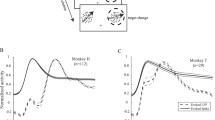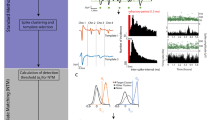Abstract
Spatio-temporal receptive fields (STRF) of visual neurons are often estimated using spike-triggered averaging of binary pseudo-random stimulus sequences. The spike train of a visual neuron is recorded simultaneously with the stimulus presentation. The neuron’s STRF is estimated by averaging the stimulus frames that coincide with spikes at fixed latencies. Although this is a widely used technique, an analytical method for determining the statistical significance of the estimated value of the STRF pixels seems to be lacking. Such a significance test would be useful for identifying the significant features of the STRF and investigating their relationship with experimental variables. Here, the distribution of the estimated STRF pixel values is derived for given spike trains, under the null hypothesis that spike occurrences and stimulus values are statistically independent. This distribution is then used for computing amplitude thresholds to determine the STRF pixels where the null hypothesis can be rejected at a desired two-tailed significance level. It is also proposed that the size of the receptive field may be inferred from the significant pixels. The application of the proposed method is illustrated on spike trains collected from individual mouse retinal ganglion cells.




Similar content being viewed by others
Availability of data and materials
The datasets analyzed during the current study are available in the CRCNS.ORG repository, http://dx.doi.org/10.6080/K0RF5RZT [32].
References
Castelfranco, A.M., Hartline, D.K.: Evolution of rapid nerve conduction. Brain Res. 1641(Pt A), 11–33 (2016). https://doi.org/10.1016/j.brainres.2016.02.015
Sherrington, C.S.: The Integrative Action of the Nervous System. C Scribner and Sons, New York (1906)
Kuffler, S.W.: Discharge patterns and functional organization of mammalian retina. J. Neurophysiol. 16, 37–68 (1953)
Hubel, D.H., Wiesel, T.: “Receptive fields and functional architecture of monkey striate cortex. J. Physiol. 195, 215–243 (1968)
Lindeberg, T.: Time-causal and time-recursive spatio-temporal receptive fields. J. Math. Imaging Vis. 55(1), 50–88 (2016). https://doi.org/10.1007/s10851-015-0613-9
Yasui, S., Davis, W., Naka, K.: Spatio-temporal receptive field measurement of retinal neurons by random pattern stimulation and cross correlation. IEEE Trans. Biomed. Eng. 26(5), 263–272 (1979)
Chichilnisky, E.J.: A simple white noise analysis of neuronal light responses. Network 12(2), 199–213 (2001)
Schwartz, O., Pillow, J.W., Rust, N.C., Simoncelli, E.P.: Spike-triggered neural characterization. J. Vis. (2006). https://doi.org/10.1167/6.4.13
Kim, I.J., Zhang, Y., Yamagata, M., Meister, M., Sanes, J.R.: Molecular identification of a retinal cell type that responds to upward motion. Nature 452, 478–482 (2008)
Lefebvre, J.L., Zhang, Y., Meister, M., Wang, X., Sanes, J.R.: Gamma-Protocadherins regulate neuronal survival but are dispensable for circuit formation in retina. Development 135, 4141–4151 (2008)
Bigelow, J., Malone, B.J.: Cluster-based analysis improves predictive validity of spike-triggered receptive field estimates. PLoS One 12(9), e0183914 (2017). https://doi.org/10.1371/journal.pone.0183914
Seilheimer, R.L., Sabharwal, J., Wu, S.M.: Genetic dissection of rod and cone pathways mediating light responses and receptive fields of ganglion cells in the mouse retina. Vis. Res. 167, 15–23 (2020). https://doi.org/10.1016/j.visres.2019.12.005
Li, H., et al.: Relationship between the dynamics of orientation tuning and spatiotemporal receptive field structures of cat LGN neurons. Neuroscience 377, 26–39 (2018). https://doi.org/10.1016/j.neuroscience.2018.02.024
Ringach, D.L., Sapiro, G., Shapley, R.: A subspace reverse-correlation technique for the study of visual neurons. Vis. Res. 37(17), 2455–2464 (1997). https://doi.org/10.1016/s0042-6989(96)00247-7
Malone, B.J., Kumar, V.R., Ringach, D.L.: Dynamics of receptive field size in primary visual cortex. J. Neurophysiol. 97(1), 407–414 (2007). https://doi.org/10.1152/jn.00830.2006
Cai, D., DeAngelis, G.C., Freeman, R.D.: Spatiotemporal receptive field organization in the lateral geniculate nucleus of cats and kittens. J. Neurophysiol. 78(2), 1045–1061 (1997). https://doi.org/10.1152/jn.1997.78.2.1045
Eckhorn, R., Krause, F., Nelson, J.I.: The RF-cinematogram. A cross-correlation technique for mapping several visual receptive fields at once. Biol. Cybern. 69(1), 37–55 (1993). https://doi.org/10.1007/BF00201407
Theunissen, F.E., David, S.V., Singh, N.C., Hsu, A., Vinje, W.E., Gallant, J.L.: Estimating spatio-temporal receptive fields of auditory and visual neurons from their responses to natural stimuli. Netw.: Comput. Neural Syst. 12(3), 289–316 (2001). https://doi.org/10.1080/net.12.3.289.316
Waleszczyk, W.J., et al.: Spectral receptive field properties of neurons in the feline superior colliculus. Exp. Brain Res. 181(1), 87–98 (2007). https://doi.org/10.1007/s00221-007-0908-1
Wallace, M.T., Meredith, M.A., Stein, B.E.: Integration of multiple sensory modalities in cat cortex. Exp. Brain Res. 91(3), 484–488 (1992). https://doi.org/10.1007/BF00227844
Wallace, M.T., Stein, B.E.: Sensory organization of the superior colliculus in cat and monkey. Prog. Brain Res. 112, 301–311 (1996). https://doi.org/10.1016/s0079-6123(08)63337-3
Lewald, J., Ehrenstein, W.H., Guski, R.: Spatio-temporal constraints for auditory–visual integration. Behav. Brain Res. 121(1–2), 69–79 (2001). https://doi.org/10.1016/S0166-4328(00)00386-7
Emerson, R.C., Citron, M.C., Vaughn, W.J., Klein, S.A.: Nonlinear directionally selective subunits in complex cells of cat striate cortex. J. Neurophysiol. 58(1), 33–65 (1987). https://doi.org/10.1152/jn.1987.58.1.33
McLean, J., Palmer, L.A.: Contribution of linear spatiotemporal receptive field structure to velocity selectivity of simple cells in area 17 of cat. Vis. Res. 29(6), 675–679 (1989). https://doi.org/10.1016/0042-6989(89)90029-1
Stevens, J.K., Gerstein, G.L.: Spatiotemporal organization of cat lateral geniculate receptive fields. J. Neurophysiol. 39(2), 213–238 (1976). https://doi.org/10.1152/jn.1976.39.2.213
DeAngelis, G.C., Ohzawa, I., Freeman, R.D.: Receptive-field dynamics in the central visual pathways. Trends Neurosci. 18(10), 451–458 (1995). https://doi.org/10.1016/0166-2236(95)94496-r
Reid, R.C., Victor, J.D., Shapley, R.M.: The use of m-sequences in the analysis of visual neurons: linear receptive field properties. Vis. Neurosci. 14(6), 1015–1027 (1997). https://doi.org/10.1017/s0952523800011743
Meister, M., Pine, J., Baylor, D.A.: Multi-neuronal signals from the retina: acquisition and analysis. J. Neurosci. Methods 51, 95–106 (1994)
Moore, B.D., Kiley, C.W., Sun, C., Usrey, W.M.: Rapid plasticity of visual responses in the adult lateral geniculate nucleus. Neuron 71(5), 812–819 (2011). https://doi.org/10.1016/j.neuron.2011.06.025
Rice, T.K., Schork, N.J., Rao, D.C.: Methods for handling multiple testing. Adv. Genet. 60, 293–308 (2008)
Armstrong, R.A.: When to use the Bonferroni correction. Ophthalmic Physiol. Opt. 34(5), 502–508 (2014). https://doi.org/10.1111/opo.12131
Zhang, Y., Asari, H., Meister, M.: Multi-electrode recordings from retinal ganglion cells. CRCNS.org (2014). https://doi.org/10.6080/K0RF5RZT
Funding
The author did not receive support from any organization for the submitted work.
Author information
Authors and Affiliations
Contributions
MO identified the problem, developed the method, performed the analyses and wrote the manuscript.
Corresponding author
Ethics declarations
Conflict of interest
No, I declare that the authors have no competing interests as defined by Springer, or other interests that might be perceived to influence the results and/or discussion reported in this paper. The author has no relevant financial or non-financial interests to disclose.
Ethical approval
Not applicable (No ethical approval was needed for the present study since the data were downloaded as computer files from http://dx.doi.org/10.6080/K0RF5RZT [32]).
Additional information
Publisher's Note
Springer Nature remains neutral with regard to jurisdictional claims in published maps and institutional affiliations.
Rights and permissions
Springer Nature or its licensor (e.g. a society or other partner) holds exclusive rights to this article under a publishing agreement with the author(s) or other rightsholder(s); author self-archiving of the accepted manuscript version of this article is solely governed by the terms of such publishing agreement and applicable law.
About this article
Cite this article
Okatan, M. A statistical significance test for spatio-temporal receptive field estimates obtained using spike-triggered averaging of binary pseudo-random sequences. SIViP 17, 3759–3766 (2023). https://doi.org/10.1007/s11760-023-02603-1
Received:
Revised:
Accepted:
Published:
Issue Date:
DOI: https://doi.org/10.1007/s11760-023-02603-1




